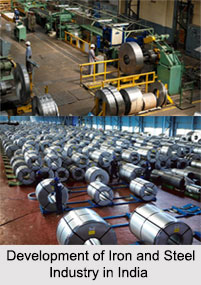 Development of Iron and Steel Industry in India was envisaged during the first Five-Year Plan, but it was during the Second Five-Year Plan that the three integrated steel projects were started at Bhilai, Rourkela and Durgapur. It has always strived for continuous modernisation and up-gradation of older plants and higher energy efficiency levels. Iron and steel Industry in India witnessed rapid growth after Independence. India produced 16.9 lakh tonnes of pig iron in. 1950-51.
Development of Iron and Steel Industry in India was envisaged during the first Five-Year Plan, but it was during the Second Five-Year Plan that the three integrated steel projects were started at Bhilai, Rourkela and Durgapur. It has always strived for continuous modernisation and up-gradation of older plants and higher energy efficiency levels. Iron and steel Industry in India witnessed rapid growth after Independence. India produced 16.9 lakh tonnes of pig iron in. 1950-51.
Production in the iron and steel segment has been escalating since the last 20 years. In 2006, India produced around 44 million tonnes of steel. India is now the 8th largest producer of steel in the world by the International Iron and Steel Institute (IISI).
Beginning of Iron and Steel Industry in India
The real beginning of modern Iron and Steel Industry in India was made in 1907 only when Tata Iron and Steel Company (TISCO) were set up at Jamshedpur in Bihar. The plant started production in 1912. A new township formed was named after Jehangir Ratanji Dadabhoy Tata, a former chairman of Tata Group.
The Indian Iron and Steel Company (IISCO) was set up in 1919 at Burnpur followed by the setting up of Mysore Steel Works at Bhadravati (now Visveswaraya Iron and Steel Works) in 1923. Excluding the Jamshedpur Steel Plant of the Tatas, all are public sector plants and looked after by the Steel Authority of India Ltd (SAIL). Tata Steel, which leads and dictates the Indian industrial scenario has spread its horizons and acquired Corus, the UK-Dutch steel company. Bokaro Steel Plant and Bhilai Steel Plant in Bhilai were set up with soviet alliance. Durgapur Steel Plant headquartered at Durgapur and Rourkela Steel Plant headquartered at Rourkela came up using British and West German technical expertise, respectively. Vishakhapatnam Steel Plant at Vishakhapatnam has the advantage of importing good quality coking coal from abroad and is at ease in exporting its products straight to the world market. In 1997-1998, it had produced near about 2.2 million tonnes of pig iron. The plant has been able to uphold international standards of competence.
Steps taken to Develop Iron and Steel Industry in India
Various new industrial policies and other initiatives undertaken by the Government of India have increased the growth of iron and steel industry. Some of the measures include low import duties, simple tax structure and unrestricted external trade. The social reforms introduced by the government improved the development process of iron and steel industries in India. As a result, expansion and modernization measures are being adopted by the units that already exist as well as numerous new plants are being set up in various regions of the nation, which are more improved, economic and cost effective and use advanced technologies. Moreover, large investments are being made in the steel plants in Odisha by the Korean company, POSCO.



















